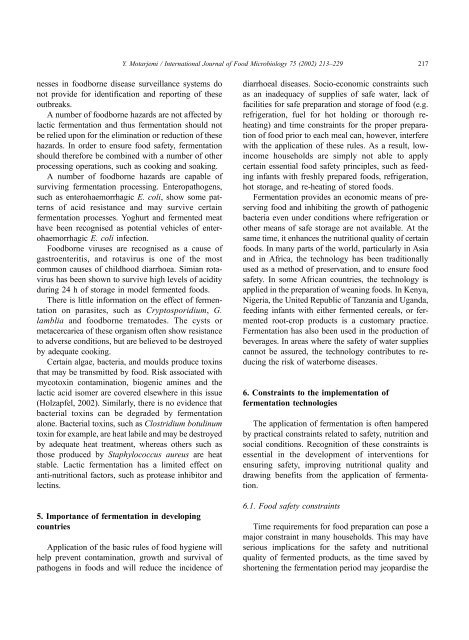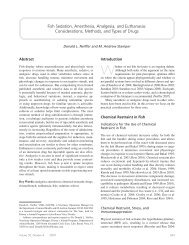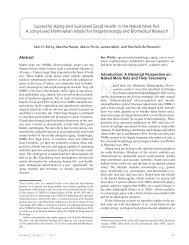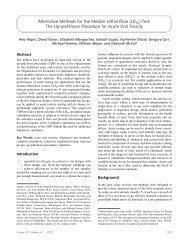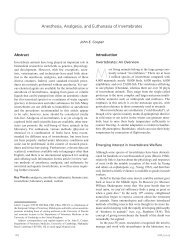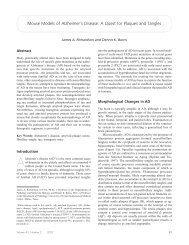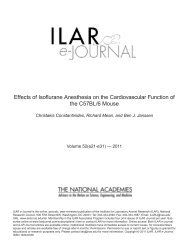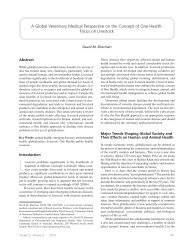Impact of small scale fermentation technology on food safety in ...
Impact of small scale fermentation technology on food safety in ...
Impact of small scale fermentation technology on food safety in ...
Create successful ePaper yourself
Turn your PDF publications into a flip-book with our unique Google optimized e-Paper software.
nesses <strong>in</strong> <strong>food</strong>borne disease surveillance systems do<br />
not provide for identificati<strong>on</strong> and report<strong>in</strong>g <str<strong>on</strong>g>of</str<strong>on</strong>g> these<br />
outbreaks.<br />
A number <str<strong>on</strong>g>of</str<strong>on</strong>g> <strong>food</strong>borne hazards are not affected by<br />
lactic <str<strong>on</strong>g>fermentati<strong>on</strong></str<strong>on</strong>g> and thus <str<strong>on</strong>g>fermentati<strong>on</strong></str<strong>on</strong>g> should not<br />
be relied up<strong>on</strong> for the elim<strong>in</strong>ati<strong>on</strong> or reducti<strong>on</strong> <str<strong>on</strong>g>of</str<strong>on</strong>g> these<br />
hazards. In order to ensure <strong>food</strong> <strong>safety</strong>, <str<strong>on</strong>g>fermentati<strong>on</strong></str<strong>on</strong>g><br />
should therefore be comb<strong>in</strong>ed with a number <str<strong>on</strong>g>of</str<strong>on</strong>g> other<br />
process<strong>in</strong>g operati<strong>on</strong>s, such as cook<strong>in</strong>g and soak<strong>in</strong>g.<br />
A number <str<strong>on</strong>g>of</str<strong>on</strong>g> <strong>food</strong>borne hazards are capable <str<strong>on</strong>g>of</str<strong>on</strong>g><br />
surviv<strong>in</strong>g <str<strong>on</strong>g>fermentati<strong>on</strong></str<strong>on</strong>g> process<strong>in</strong>g. Enteropathogens,<br />
such as enterohaemorrhagic E. coli, show some patterns<br />
<str<strong>on</strong>g>of</str<strong>on</strong>g> acid resistance and may survive certa<strong>in</strong><br />
<str<strong>on</strong>g>fermentati<strong>on</strong></str<strong>on</strong>g> processes. Yoghurt and fermented meat<br />
have been recognised as potential vehicles <str<strong>on</strong>g>of</str<strong>on</strong>g> enterohaemorrhagic<br />
E. coli <strong>in</strong>fecti<strong>on</strong>.<br />
Foodborne viruses are recognised as a cause <str<strong>on</strong>g>of</str<strong>on</strong>g><br />
gastroenteritis, and rotavirus is <strong>on</strong>e <str<strong>on</strong>g>of</str<strong>on</strong>g> the most<br />
comm<strong>on</strong> causes <str<strong>on</strong>g>of</str<strong>on</strong>g> childhood diarrhoea. Simian rotavirus<br />
has been shown to survive high levels <str<strong>on</strong>g>of</str<strong>on</strong>g> acidity<br />
dur<strong>in</strong>g 24 h <str<strong>on</strong>g>of</str<strong>on</strong>g> storage <strong>in</strong> model fermented <strong>food</strong>s.<br />
There is little <strong>in</strong>formati<strong>on</strong> <strong>on</strong> the effect <str<strong>on</strong>g>of</str<strong>on</strong>g> <str<strong>on</strong>g>fermentati<strong>on</strong></str<strong>on</strong>g><br />
<strong>on</strong> parasites, such as Cryptosporidium, G.<br />
lamblia and <strong>food</strong>borne trematodes. The cysts or<br />
metacercariea <str<strong>on</strong>g>of</str<strong>on</strong>g> these organism <str<strong>on</strong>g>of</str<strong>on</strong>g>ten show resistance<br />
to adverse c<strong>on</strong>diti<strong>on</strong>s, but are believed to be destroyed<br />
by adequate cook<strong>in</strong>g.<br />
Certa<strong>in</strong> algae, bacteria, and moulds produce tox<strong>in</strong>s<br />
that may be transmitted by <strong>food</strong>. Risk associated with<br />
mycotox<strong>in</strong> c<strong>on</strong>tam<strong>in</strong>ati<strong>on</strong>, biogenic am<strong>in</strong>es and the<br />
lactic acid isomer are covered elsewhere <strong>in</strong> this issue<br />
(Holzapfel, 2002). Similarly, there is no evidence that<br />
bacterial tox<strong>in</strong>s can be degraded by <str<strong>on</strong>g>fermentati<strong>on</strong></str<strong>on</strong>g><br />
al<strong>on</strong>e. Bacterial tox<strong>in</strong>s, such as Clostridium botul<strong>in</strong>um<br />
tox<strong>in</strong> for example, are heat labile and may be destroyed<br />
by adequate heat treatment, whereas others such as<br />
those produced by Staphylococcus aureus are heat<br />
stable. Lactic <str<strong>on</strong>g>fermentati<strong>on</strong></str<strong>on</strong>g> has a limited effect <strong>on</strong><br />
anti-nutriti<strong>on</strong>al factors, such as protease <strong>in</strong>hibitor and<br />
lect<strong>in</strong>s.<br />
5. Importance <str<strong>on</strong>g>of</str<strong>on</strong>g> <str<strong>on</strong>g>fermentati<strong>on</strong></str<strong>on</strong>g> <strong>in</strong> develop<strong>in</strong>g<br />
countries<br />
Y. Motarjemi / Internati<strong>on</strong>al Journal <str<strong>on</strong>g>of</str<strong>on</strong>g> Food Microbiology 75 (2002) 213–229 217<br />
Applicati<strong>on</strong> <str<strong>on</strong>g>of</str<strong>on</strong>g> the basic rules <str<strong>on</strong>g>of</str<strong>on</strong>g> <strong>food</strong> hygiene will<br />
help prevent c<strong>on</strong>tam<strong>in</strong>ati<strong>on</strong>, growth and survival <str<strong>on</strong>g>of</str<strong>on</strong>g><br />
pathogens <strong>in</strong> <strong>food</strong>s and will reduce the <strong>in</strong>cidence <str<strong>on</strong>g>of</str<strong>on</strong>g><br />
diarrhoeal diseases. Socio-ec<strong>on</strong>omic c<strong>on</strong>stra<strong>in</strong>ts such<br />
as an <strong>in</strong>adequacy <str<strong>on</strong>g>of</str<strong>on</strong>g> supplies <str<strong>on</strong>g>of</str<strong>on</strong>g> safe water, lack <str<strong>on</strong>g>of</str<strong>on</strong>g><br />
facilities for safe preparati<strong>on</strong> and storage <str<strong>on</strong>g>of</str<strong>on</strong>g> <strong>food</strong> (e.g.<br />
refrigerati<strong>on</strong>, fuel for hot hold<strong>in</strong>g or thorough reheat<strong>in</strong>g)<br />
and time c<strong>on</strong>stra<strong>in</strong>ts for the proper preparati<strong>on</strong><br />
<str<strong>on</strong>g>of</str<strong>on</strong>g> <strong>food</strong> prior to each meal can, however, <strong>in</strong>terfere<br />
with the applicati<strong>on</strong> <str<strong>on</strong>g>of</str<strong>on</strong>g> these rules. As a result, low<strong>in</strong>come<br />
households are simply not able to apply<br />
certa<strong>in</strong> essential <strong>food</strong> <strong>safety</strong> pr<strong>in</strong>ciples, such as feed<strong>in</strong>g<br />
<strong>in</strong>fants with freshly prepared <strong>food</strong>s, refrigerati<strong>on</strong>,<br />
hot storage, and re-heat<strong>in</strong>g <str<strong>on</strong>g>of</str<strong>on</strong>g> stored <strong>food</strong>s.<br />
Fermentati<strong>on</strong> provides an ec<strong>on</strong>omic means <str<strong>on</strong>g>of</str<strong>on</strong>g> preserv<strong>in</strong>g<br />
<strong>food</strong> and <strong>in</strong>hibit<strong>in</strong>g the growth <str<strong>on</strong>g>of</str<strong>on</strong>g> pathogenic<br />
bacteria even under c<strong>on</strong>diti<strong>on</strong>s where refrigerati<strong>on</strong> or<br />
other means <str<strong>on</strong>g>of</str<strong>on</strong>g> safe storage are not available. At the<br />
same time, it enhances the nutriti<strong>on</strong>al quality <str<strong>on</strong>g>of</str<strong>on</strong>g> certa<strong>in</strong><br />
<strong>food</strong>s. In many parts <str<strong>on</strong>g>of</str<strong>on</strong>g> the world, particularly <strong>in</strong> Asia<br />
and <strong>in</strong> Africa, the <str<strong>on</strong>g>technology</str<strong>on</strong>g> has been traditi<strong>on</strong>ally<br />
used as a method <str<strong>on</strong>g>of</str<strong>on</strong>g> preservati<strong>on</strong>, and to ensure <strong>food</strong><br />
<strong>safety</strong>. In some African countries, the <str<strong>on</strong>g>technology</str<strong>on</strong>g> is<br />
applied <strong>in</strong> the preparati<strong>on</strong> <str<strong>on</strong>g>of</str<strong>on</strong>g> wean<strong>in</strong>g <strong>food</strong>s. In Kenya,<br />
Nigeria, the United Republic <str<strong>on</strong>g>of</str<strong>on</strong>g> Tanzania and Uganda,<br />
feed<strong>in</strong>g <strong>in</strong>fants with either fermented cereals, or fermented<br />
root-crop products is a customary practice.<br />
Fermentati<strong>on</strong> has also been used <strong>in</strong> the producti<strong>on</strong> <str<strong>on</strong>g>of</str<strong>on</strong>g><br />
beverages. In areas where the <strong>safety</strong> <str<strong>on</strong>g>of</str<strong>on</strong>g> water supplies<br />
cannot be assured, the <str<strong>on</strong>g>technology</str<strong>on</strong>g> c<strong>on</strong>tributes to reduc<strong>in</strong>g<br />
the risk <str<strong>on</strong>g>of</str<strong>on</strong>g> waterborne diseases.<br />
6. C<strong>on</strong>stra<strong>in</strong>ts to the implementati<strong>on</strong> <str<strong>on</strong>g>of</str<strong>on</strong>g><br />
<str<strong>on</strong>g>fermentati<strong>on</strong></str<strong>on</strong>g> technologies<br />
The applicati<strong>on</strong> <str<strong>on</strong>g>of</str<strong>on</strong>g> <str<strong>on</strong>g>fermentati<strong>on</strong></str<strong>on</strong>g> is <str<strong>on</strong>g>of</str<strong>on</strong>g>ten hampered<br />
by practical c<strong>on</strong>stra<strong>in</strong>ts related to <strong>safety</strong>, nutriti<strong>on</strong> and<br />
social c<strong>on</strong>diti<strong>on</strong>s. Recogniti<strong>on</strong> <str<strong>on</strong>g>of</str<strong>on</strong>g> these c<strong>on</strong>stra<strong>in</strong>ts is<br />
essential <strong>in</strong> the development <str<strong>on</strong>g>of</str<strong>on</strong>g> <strong>in</strong>terventi<strong>on</strong>s for<br />
ensur<strong>in</strong>g <strong>safety</strong>, improv<strong>in</strong>g nutriti<strong>on</strong>al quality and<br />
draw<strong>in</strong>g benefits from the applicati<strong>on</strong> <str<strong>on</strong>g>of</str<strong>on</strong>g> <str<strong>on</strong>g>fermentati<strong>on</strong></str<strong>on</strong>g>.<br />
6.1. Food <strong>safety</strong> c<strong>on</strong>stra<strong>in</strong>ts<br />
Time requirements for <strong>food</strong> preparati<strong>on</strong> can pose a<br />
major c<strong>on</strong>stra<strong>in</strong>t <strong>in</strong> many households. This may have<br />
serious implicati<strong>on</strong>s for the <strong>safety</strong> and nutriti<strong>on</strong>al<br />
quality <str<strong>on</strong>g>of</str<strong>on</strong>g> fermented products, as the time saved by<br />
shorten<strong>in</strong>g the <str<strong>on</strong>g>fermentati<strong>on</strong></str<strong>on</strong>g> period may jeopardise the


